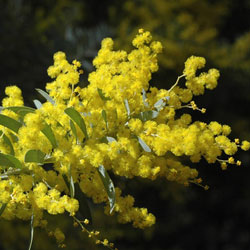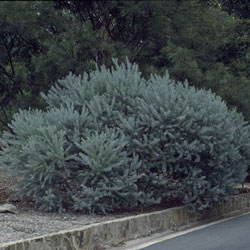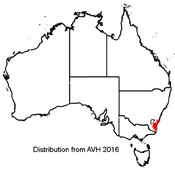Acacia covenyi
 |
 |
Blue Bush
Acacia covenyi or Blue Bush is a rare Acacia, endemic to Deua National Park, south eastern New South Wales. It forms multi-branched shrubs to tall, single stemmed evergreen trees that reach 6 to 7.5 metres. The bark is smooth and greyish with the "leaves" (actually phyllodes) being blue-grey and reaching 1.5 to 6 cm long. Flowers are lemon coloured and are produced in mass in early autumn, with black seeds maturing between late autumn and early winter.
Acacia covenyi has many horticulturally desirable attributes including its ability to withstand a variety of soil types, from sandy to moderately heavy clay, and pH levels, between pH 6 and pH 8. It is quick growing although relatively short lived (10 to 15 years). It is excellent for specimen trees and hedges, and has a non-invasive root system. Acacia covenyi does suffer from fasciation, likely resulting from a low genetic diversity in cultivated plants, and may also be prone to attack by scale insects.
Propagation is by seed which must be scarified through abrasion (using sandpaper) or thermal treatment (boiling water poured on the seed and let to sit for 24 hours) before successful germination can occur. Treated seeds are then sown singly into good quality potting mix. Germination should occur in approximately seven days.
When planting an Acacia covenyi seedling dig a hole wider than deeper, loosening the soil around the edge. If soil is heavy gypsum can be applied to improve soil condition. After digging a hole to approximately the same depth as the container, position the plant in the centre of the hole, backfill with soil, and water thoroughly. Plant may need additional water during the establishment period and during extended dry or hot periods. A light application of a native slow release fertiliser once a year in mid spring will increase the growth rate if required.
When pruning Acacia covenyi for a lollipop shape start with a plant with a single stem and allow to grow to the desired trunk height. At this point pinch out the growing tip to encourage new growth. As the plant grows continually pinch new growth until tree reaches two metres. When pruning Acacia covenyi for a hedge use young plants of any shape but start pinching out growth points when first planted. Continue to pinch new shoots ensuring that the base is wider than the top. Regular pruning must occur to maintain a dense hedge.
Tate Hancox, Volunteer Botanical Training Program Participant 2016
Name meaning: Acacia covenyiAcacia - from "acis' meaning sharp point, tip, thorn or barb in Greek covenyi - after Robert George ("Bob") Coveny, a botanist at the National Herbarium of New South Wales |
References:
Australian National Herbarium (2016). Biographical Notes - Robert George Coveny (1943 – ). Available at http://www.anbg.gov.au/biography/coveny-robert-george.html [Accessed 2 Feb. 2016].
AVH (2016). Australia's Virtual Herbarium, Council of Heads of Australasian Herbaria. Available at http://avh.chah.org.au/ [Accessed 2 Feb. 2016].
Briggs, J. & Leigh, J. (1996). Rare or threatened Australian plants. CSIRO, Collingwood, Vic.,Australia.
Tindale, M. (1980). Notes on Australian taxa of Acacia No. 6, Telopea 1(6): 429-449.
Wrigley, J. and Fagg, M. (2013). Australian Native Plants: cultivation, use in landscaping and propagation. Reed New Holland, Chatswood, N.S.W.
Hunstone, J. (2016) Horticulturist, Australian National Botanic Gardens. pers. comm.
Taylor, D. (2016) Curator - Living Collections, Australian National Botanic Gardens. pers. comm.
![An Australian Government Initiative [logo]](/images/austgovt_brown_90px.gif)


